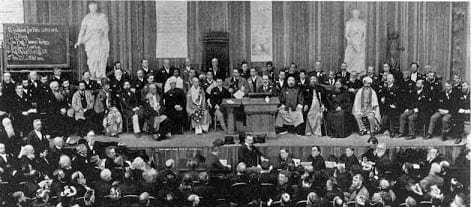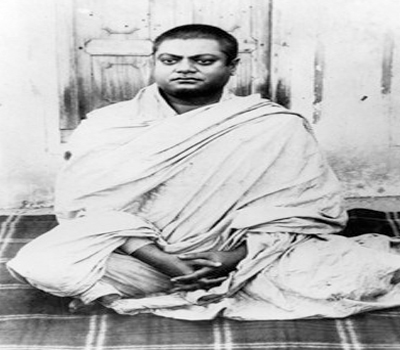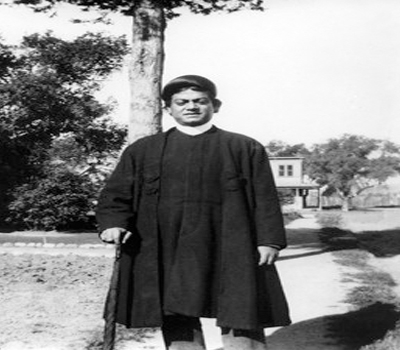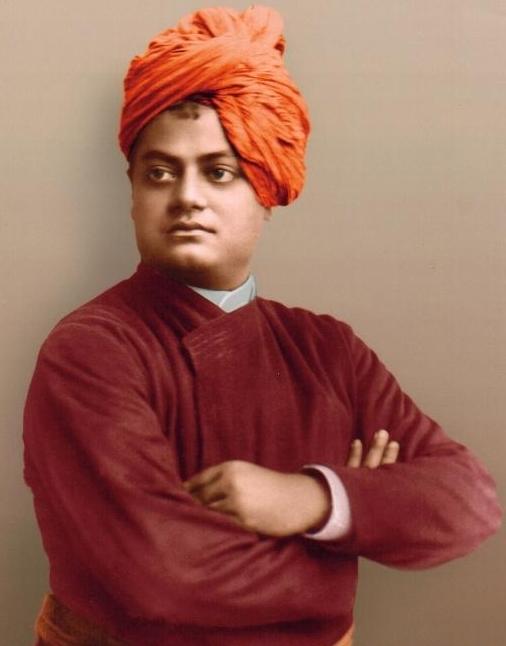The Vision and Mission of Swami Vivekananda
(Continued from the previous issue. . .)
Part 2
Role of Religion and Spirituality
Swami Vivekananda was the first person to introduce the need of religious harmony for the progress of the world, on an international platform in the most scientific manner, yet without losing the spiritual content. Cultural historian Thomas Berry sees religion, along with education and business as the major societal drivers of change.
Religion is an important driver in society that influences all aspects of life, since 80-90 percent of the world population belong to one or the other of the ten thousand or so religions of this world.10 Religion is the sum total of the belief system, rituals and, practices followed by the people in quest of God. Spirituality is the ultimate realization of the self/God/ almighty reached by following the methods prescribed by the religions.
The effort to build a harmonious, sustainable, peaceful and secure world could advance dramatically if religious people and institutions on one hand and policy makers and advocates of modern sustainable development on the other, were to embrace each other’s central concerns. Religions possess one or more of five sources of power:11
- They shape people’s world view and wield moral authority
- Have the ear of multitude of adherents
- Strong financial and institutional assets
- Strong generators of social capital
- An asset in community building
If all these five sources of power are properly synchronized in thoughts and harmonized in actions, the socio-economic and spiritual capital generated would be sufficient to find permanent solutions to the above crises and fill the world with prosperity, progress and peace. Hence religious harmony can be a strong instrument in assuring individual, family, community, nation and the world with peace and development. In spite of scientific studies, technological inventions, social innovations and political policies to assure peace and prosperity in society, these problems of the world have assumed alarming proportions, and hence it is time to search for cultural and religious options, for permanent solutions.12
The ‘Global Ethic’ proposed at the World Religions Conference held in Chicago in 1993 observed that the planet could not be changed for the better, unless the inner transformation of the individuals takes place by the awakening of the spiritual powers through reflection, meditation, prayer or positive thinking. Swami Vivekananda who teaches with emphasis about the potential divinity enshrined in each soul, has great relevance, while defining, discussing, designing and implementing various models of development by international experts.
Swamiji’s Vision and Mission on Development
Swami Vivekananda says, ‘Man has wanted to look beyond, wanted to expand himself; and all that we call progress, evolution, has been always measured by that one search for human destiny, the search for God.’13
Swamiji also says that there was nothing like religion that had brought to man more blessings, and yet at the same time, there was nothing that had brought more horror than religion. He adds that variety is the law of nature and hence birth and growth of more and more religions are quite natural. But that doesn’t mean that they are contradictory. He says, ‘I believe that they are not contradictory; they are supplementary. Each religion, as it were, takes up one part of the universal truth, and spends its whole force in embodying and typifying that part of great truth. It is therefore addition, not exclusion . . . and this is the march of the humanity.’14 Therefore, the message is that there is enough space in each religion’s part of the universal truth, for mutual understanding, cooperation and harmony.
Add Spiritual Capital
Swamiji made it further clear in the following words.
I accept all religions that were in the past, and worship with them all; I worship God with every one of them, in whatever form they worship Him. I shall go to the mosque of the Mohammedan; I shall enter the Christian’s church and kneel before the crucifix; I shall enter the Buddhist temple where I shall take refuge in Buddha and in his law. I shall go to the forest and sit down in meditation with the Hindu, who is trying to see the light, which enlightens the heart of everyone.15
This approach of Swamiji, rooted in him from the realization of the eternal values of Hindu culture and wisdom, made him the lighthouse of modern approaches to religion, spirituality and development. This is spiritual capital which is the foundation and a pre condition of all forms of development. He said,
The spectacular achievements in science and technology, and the radical socio-political changes made the need of an integral view of life capable of bringing about an all-round reconciliation of conflicting ideas and ideals of the modern age and fulfilling the aspirations of the human soul newly emancipated from centuries of superstitions and dogmatism.16
Swamiji said that he was proud to belong to a religion which had taught the world both tolerance and universal acceptance. He also said that Indians not only believed in universal toleration, but also accept all religions as true. He concluded the historic thrilling speech by giving the message of universal unity from quoting Bhagavad Gita. The concluding remarks were like cold water poured upon the fire of fanaticism and persecution that prevailed in the world, in the name of religion in the world.
Swamiji experienced the universal unity and harmony from his guru, Sri Ramakrishna, who was the king of Ecstasy, derived from the experience of real religious practice. From this great guru, Swamiji learned that the best form of true religion was to see Shiva reflected in living humans, and especially in the poor.
During his travels, Swamiji lived like a ‘mendicant monk, sometime having his meal cooked by a cobbler, sometime sharing his pipe with a sweeper, sometimes living in the palaces of Kings and Princes’ thus not only preaching, but also practicing the ideals of harmony and unity, beyond caste, colour, creed , and religion. He also warned people not to quarrel about caste and religion because, ‘the moment you quarrel, you are not going Godward, you are going backward, towards brutes.’17
How to bring Harmony in and among Religions?
Without a spiritual counterbalance, the materialistic emphasis in modern thinking about development may actually be detrimental to the personal and societal betterment it purports to bring about.18
Swamiji first recognizes that to bring harmony in religion is very difficult. But his vision became very clear, when he divided religion into three parts—philosophy, mythology and rituals. When the spirit of these three aspects is realized by every follower of all the religions, the individual reaches the realm of universal religion, where peace and harmony prevails. The Universal religion of Swamiji recognizes the natural necessity of variation. He adds, ‘through high philosophy or low, through the most exalted mythology or the grossest, through the most refined ritualism or arrant fetishism, every sect, every soul, every nation, every religion, consciously or unconsciously is struggling upward towards God; every vision of truth that man has is a vision of Him and of none else.’19 The realization that God could be reached through different paths, is the basis of peace and harmony in universal religion.
The mission for realizing this vision was education. Swamiji believed that education should help bring out the perfection which is already in man. This perfection is the reflection of the divinity in man. Divine quality makes a man capable of achieving physical, mental, intellectual and spiritual development. This development helps institutions, communities, nations and the world as a whole reach the zenith of secular and spiritual progress. At this level, all forms of traditional and modern capital—material, financial, environmental, human, social and spiritual—act and interact with one another and blend the human physical, mental, intellectual and spiritual faculties to form the basis of a divine development model.
Thus, the idea of development that Swamiji conceived was of an integrated and holistic nature consisting of the spiritual and secular aspects. While the most modern development models like sustainable development and inclusive growth are more inclined to material welfare only, Swamiji’s ideas of development depict a complete picture of the interrelatedness and interconnections between the internal and external nature.
Swamiji owed the intricacies of spirituality from the ‘Seraphic Master’ who had spent his whole life at the feet of the Divine Beloved, the Mother—the Living God. But, the consciousness of his mission only came and took possession of him after years of direct experience, wherein he saw with his own eyes and touched with his own hands the miserable and glorious body of humanity—his Mother India in all her tragic nakedness.
Swamiji worked for the regeneration of the Mother country, the resurrection of the spiritual powers of India and their diffusion throughout the universe.”20
The first step in the mission of Swamiji was to tackle the twin problems of poverty and ignorance from his own motherland. Swamiji went to the West on behalf of the people and the poor.
The Math and the Mission
The Ramakrishna Math and Mission is the best example of Swamiji’s idea of developing mother India. The objectives, policies, programmes and the work culture of the Math and Mission centres all over the world have shown a secular modus operandi of development with spiritual convictions. The Ramakrishna Math and Mission Centres and the Sri Sarada Math centres are the institutions that give a body and spirit to the message and teachings of Sri Ramakrishna, Holy Mother and Swamiji. The aims of the Math and Mission, as defined in the Memorandum annexed to the act of registration of 1909, are divided into three classes:
- Charitable work
- Missionary works (organization and publications)
- Educational works.
Apart from the regular spiritual services, the institution offers emergency services during times of natural or man-made disasters, both inside and outside the country.
Through the 123 Ramakrishna centres in India and 40 foreign centres, these institutions are rendering yeomen service in the field of education, health, rehabilitation, service to the tribals, women, youth and religion and spirituality. Right from its beginning, the Mission has been engaged in the relief activities of the people affected by flood, earth quake, fire, tornado, etc. In the year 2003-2004, the organization extended help to 2,55,000 people belonging to 759 villages in India, by spending about 26 million rupees.21 In the health sector, the Mission is giving free medical aid and treatment to millions of poor people in the remote villages of India with its 15 hospitals, 120 outdoor dispensaries and 46 mobile dispensaries. In the educational sector, the mission has 1 University, 12 colleges, 428 schools, 2 language schools, 4 polytechnics, 119, hostels, 6 orphanages, 2 centres for the differently-abled, and 270 Non-formal educational institutions. The activities of the Mission for women, tribals and the youth are also appreciable.
Along with these secular welfare activities, the spiritual and religious activities are also worth mentioning. The Math and the Mission are promoting ‘Sarvadharma Samabhavana’ culture in which all systems of beliefs are equally treated. Festivals of all religions are celebrated and the sannyasins of the Math play a positive role to bring down tensions in the name of religions in various parts of India.
The Ramakrishna Math and Mission is an institution where the oneness of the universe is taught and practised. Harmony of religions and peace in the society are its core messages. In a globalised world order, where cutthroat competition and the consequent conflicts are threatening the world peace and harmony, the holistic development model preached and practiced by the Math and Mission based on the ultimate divinity and the inherent and infinite potentiality of human beings will make the future more perfect.
(Concluded.)
References
- World Watch Report No. 164, 2002
- Ibid, p-5
- World Summit on Sustainable Development, Report, 2002
- CW, 2:359
- CW, 2:365
- CW, 2:374
- Swami Vivekananda’s Address at the World’s Parliament of Religions, Belur Math, 1993, p-5
- CW, 3:132
- CW, 3:9
- CW, 2:383
- Romain Roland, Life of Vivekananda
- President, Ramakrishna Math, Trichur, Ramakrishna Mathavum Ramakrishna Missionum (Malayalam), 2010. For latest statistics, please visit Belur Math website: www.belurmath.org
Rights versus Duties
All the prophets and great religious personalities were lovers of the poor. They came for all and not for the rich alone. Our society also was built on a socialistic outlook. Our law givers never talked of rights but only of duties. Duties were fixed for everyone from the king to the man in the street, and also for the four castes, which were to serve society according to capacity of each, without claiming any privilege for their services. So also duties were fixed for the members of the four Ashramas or stages of life. It was all duties and no rights. Everyone was expected to work for the nation through his prescribed duties. The present day outlook lays stress on rights rather than on duties, which is alien to our culture. Through the honest performance of duties one can not only serve the nation, but also progress spiritually. By fighting for rights this cannot be done. Swamiji has again and again pointed out to us that ‘the twin ideals of India are renunciation and service.’
—Swami Vireswarananda, 10th President of the Ramakrishna Order
Source : Vedanta Kesari, July, 2016







Leave A Comment